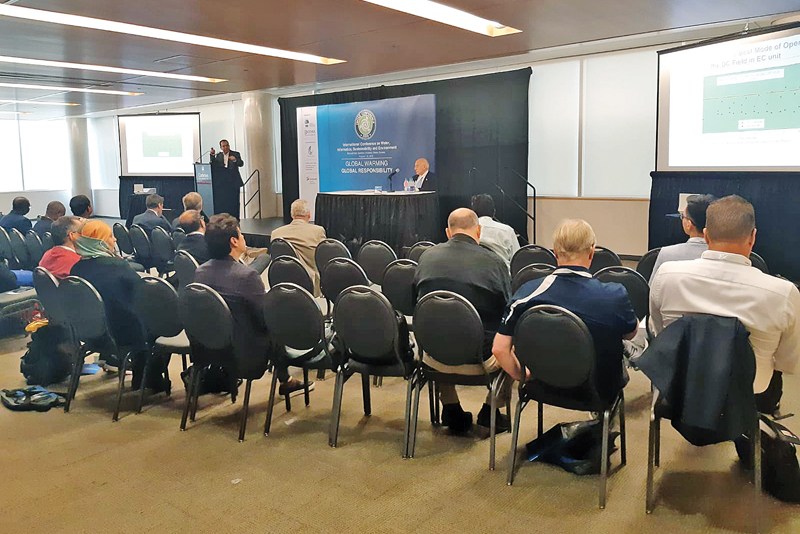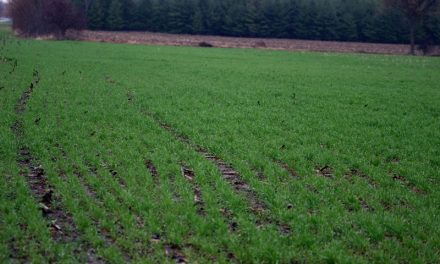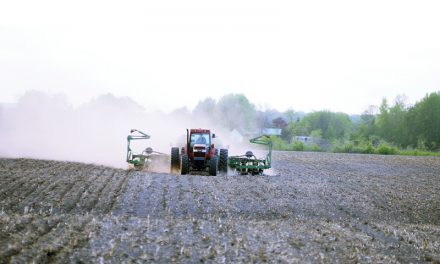Global sustainability
Participants at the International Conference on Water, Informatics, Sustainability, and Environment (iWISE) discussed global warming and environmental issues at Ottawa’s Carleton University in August. Al-Rajab photo

From left, James Birtch (Ottawa Biosphere Eco-City Initiative) presents certificates of participation to John McEwen (Metro Vancouver board director and Mayor of Anmore [a semi-rural community in Metro Vancouver]) and Professor Farouk El-Baz (director of the Centre for Remote Sensing, Boston University, U.S).
Al-Rajab photo
OTTAWA – “Global warming – global responsibility” was the main topic of the third version of the International Conference on Water, Informatics, Sustainability, and Environment (iWISE) held at Carleton University during Aug. 7-9. Local and international academic and professional bodies participated in the event. Total attendance for the conference was approximately 100, with over 40 presentations included in the program. The conference was centred on the themes of water, informatics, sustainability, and the environment; all of which relate to global warming and climate change. Together, conference attendees drew linkages between these themes, and learned about cutting-edge research, technology and practice in these fields. Field-leading experts delivered keynote speeches, while focused themed sessions offered the opportunity to delve deeper into specific issues and solutions.
Biosolids management
Biosolids management, wastewater treatments technologies and related emerging contaminants were discussed in different sessions.
Professor Banu Ormeci, department of civil and environmental engineering at Carleton University, gave an overview about the biosolids management in circular economy around the world. Dr. Ormeci explained that biosolids treatment and management is a growing challenge for treatment plants globally. The cost of biosolids treatment constitutes approximately half of the cost of wastewater treatment, and the quantity increases as new wastewater treatment facilities are built and existing ones are upgraded to keep up with the growing population and stricter regulations that require advanced treatment. Unlike linear economy that was built on the “take, make and dispose” philosophy, circular economy emphasizes recovering and reusing resources as long as possible. The circular economy concept and its application to biosolids treatment and management has immensely helped to advance the science, research and technology in achieving recovery of nutrients, energy, carbon, and bio-products from sludge. The European Commission implemented closing the loop – an EU Action Plan for the Circular Economy in 2015 and several other countries are now in the process of implementing similar action plans including Canada (e.g., Ontario’s new Strategy for a Waste-Free Ontario: Building the Circular Economy).
Separately, Dr. AJ Al-Rajab from Etcetera Publications, Canada, discussed the pharmaceuticals and personal care products as emerging pollutants in water. He mentioned that pharmaceuticals and personal care products (PPCPs) were frequently detected in treated wastewater, surface and groundwater worldwide. Some PPCPs were reported to be persistent in the environment and their removal was inefficient at wastewater treatment plants (WWTPs). The main sources of PPCPs in the environment are the WWTPs, landfills and medical disposal. The environmental behaviour of PPCPs was discussed in different studies worldwide.
Help society embrace sustainability
Sustainability is essential for the survival of humanity and of the biosphere, on which it depends.
This topic was discussed by James Birtch, Ottawa Biosphere Eco-City Initiative (founder & former chairman). The increase in humanity’s power through science, engineering and organization has permitted a world culture focused on immediate needs and wants, but not on long-term survival. Hard and soft science, and their practitioners, need to work together and help society embrace sustainability; this will create a culture of sustainability and produce. Planning has produced dozens of sustainable cities, but cannot win the battle against time. Most of the world’s 3,000 cities lack the resources to become sustainable cities through planning; yet they all possess human capital, the energy and ideas of people that can produce sustainability, with techniques to engage people, such as the Biosphere Eco-City approach; society will embrace sustainability and produce needed cultural change worldwide. Cultures grow through countless individual actions from the culture of agriculture thousands of years ago, the culture of cities, to the more recent culture of the open-source movement and cell phone culture. A culture of sustainability will direct government actions, business decisions and the daily actions of ordinary people. Specialists in sustainability will benefit from greater demand and funding for their services, and faster acceptance of their innovations. In turn, they can promote models of engagement, volunteer in community initiatives, create demonstration projects and bring together hard and soft science to help society embrace sustainability. “This will produce a good future,” Birtch added.
Resolving global climate inequity
“Resolving global climate inequity through large-scale climate financing and community-based solutions” was presented by Dale Marshall, national climate program manager, Environment Defence, Canada. It is generally understood that those who are least responsible for the problem of climate change are those who have been hit first and hardest. However, it is rarely acknowledged in industrialized countries such as Canada the degree to which global solutions like the Paris Agreement on climate change fail to fully address this global inequity. Countries’ mitigation commitments begin with grandfathering high levels of carbon emissions. Meanwhile the differential impacts of climate change, and their imposed costs, are only minimally resolved. For communities in the developing world, the impacts of climate change are often linked to water and water resources: not enough, too much, poor quality, etc. Access to clean water is a human right and fundamental to community well-being. This is why resolving climate inequity must include a full, comprehensive approach to water access for all. The Paris Agreement acknowledges climate equity issues but only minimally addresses them. Over the coming years, commitments and action need to be ramped up to avoid catastrophic impacts in the developing world and global instability. In addition to greater mitigation commitments, higher levels of climate financing are needed to allow developing counties, especially least developed countries, to both address the mounting impacts of climate change and undertake low-carbon development. The solutions need to be participatory and community based in order to integrate technological solutions that are appropriate. Marshall added, “Significant resources are also needed for capacity building, including at the local level.”

Pink Lake, in Gatineau, Que., was named for the nearby Pink family who settled the land in 1826.
Al-Rajab photo
Pink Lake is actually green!
Birtch was the guide of the conference tour on the third and last day. Three stops marked the half day tour, including Hog’s back park, the Canadian Museum of History, and Pink Lake in Gatineau.
Birtch explained to visitors that Pink Lake is meromictic, which means that water in the lower part of the lake does not mix with that in the upper part. The bottom 7 m of this 20 m deep lake does not have oxygen. There is algae in that lower layer that photosynthesizes with sulphur instead of carbon dioxide (CO2). Pink Lake was named for the nearby Pink family who settled the land in 1826. Algae makes the lake green.
The area of the lake was probably a pothole when the continental ice sheet retreated 9,000 years ago. Then the land was covered by the Champlain Sea, until isostatic rebound brought it up above sea level. The small lake was filled with sea water, which remained for a time because a high ridge surrounded it. The ridge prevented streams from flowing into the lake or prevented winds from blowing on the lake surface – two processes that mix the water in most lakes. It took so long for the trapped seawater to become fresh water in the lake. The three-spined stickleback evolved from a seawater fish to a freshwater fish.
Pink Lake was a popular swimming and party area but human activities present a danger of eutrophication – where excess nutrients cause excessive plant growth that takes oxygen from the water in the upper layer (there is none in the lower layer). As a result, access to the water is restricted. The trail around the lake is about 2.5 km, is a well maintained trail and includes stairs and slopes; it is safe but involves exercise. Birtch added, “You may see birds above, three-spined stickleback fish near the shore, and old pits where people used to mine mica.”
Full details about the conference and its program are available online at www.iwiseconference.com/2019.













